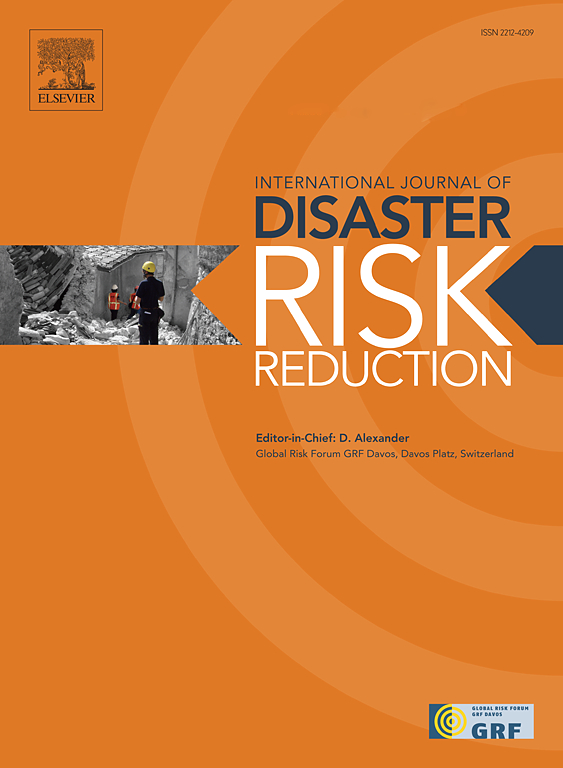探索增强现实游戏中时间压力和干扰因素对应急准备的影响
IF 4.2
1区 地球科学
Q1 GEOSCIENCES, MULTIDISCIPLINARY
International journal of disaster risk reduction
Pub Date : 2024-11-01
DOI:10.1016/j.ijdrr.2024.104900
引用次数: 0
摘要
培养应急准备和响应技能对于确保自然灾害期间的个人安全和福祉至关重要。逼真且引人入胜的游戏可以有效提高这些技能。本文探讨了在增强现实(AR)游戏中引入额外游戏对象作为干扰因素和时间压力对用户体验和应急准备意愿的影响。在游戏场景中加入了额外的、分散注意力的游戏元素和时间压力,以模拟真实紧急情况下的认知需求和压力。为了研究分散注意力的游戏元素和时间压力的影响,我们对 52 名参与者进行了一项主体内研究,他们玩了两个不同版本的 AR 游戏,游戏的目的是帮助找到应急包的推荐物品。在第一个版本中,参与者只专注于寻找推荐物品,而在第二个版本中,则引入了干扰因素和计时器,以强调打包的紧迫性。结果显示,两个版本的用户体验没有明显差异。不过,有时间压力和分心因素的版本在应对疏散警告时立即采取行动的态度和感知行为控制方面有明显改善。参与者的定性反馈也支持这些效果。这些研究结果为进一步的研究提出了新的方向,并强调了 AR 游戏在增强应急响应策略方面的潜力。本文章由计算机程序翻译,如有差异,请以英文原文为准。
Exploring the effects of time pressure and distracting elements in an Augmented Reality game for emergency preparedness
The development of emergency preparedness and response skills is crucial for ensuring individual safety and well-being during natural disasters. Realistic and engaging games can effectively promote these skills. This paper explores the impact of introducing additional game objects as distractors and time pressure on user experience and willingness to prepare for emergencies in an Augmented Reality (AR) game. Additional, distracting game elements and time pressure are included in the game scenario to simulate the cognitive demands and stress experienced in real emergency situations. To investigate the impact of distracting game elements and time pressure, a within-subjects study was conducted with 52 participants who played two different versions of an AR game designed to help locate recommended items for an emergency grab bag. In the first version, participants focused solely on finding the recommended items, while in the second version, distractors and a timer were introduced to emphasize the urgency of packing the bag. The results showed no significant difference in user experience between the two versions. However, the version with time pressure and distractors demonstrated a significant improvement in attitudes and perceived behavioral control regarding immediate actions in response to evacuation warnings. Qualitative feedback from participants supported these effects. These findings suggest new directions for further research and highlight the potential of AR games to enhance emergency response strategies.
求助全文
通过发布文献求助,成功后即可免费获取论文全文。
去求助
来源期刊

International journal of disaster risk reduction
GEOSCIENCES, MULTIDISCIPLINARYMETEOROLOGY-METEOROLOGY & ATMOSPHERIC SCIENCES
CiteScore
8.70
自引率
18.00%
发文量
688
审稿时长
79 days
期刊介绍:
The International Journal of Disaster Risk Reduction (IJDRR) is the journal for researchers, policymakers and practitioners across diverse disciplines: earth sciences and their implications; environmental sciences; engineering; urban studies; geography; and the social sciences. IJDRR publishes fundamental and applied research, critical reviews, policy papers and case studies with a particular focus on multi-disciplinary research that aims to reduce the impact of natural, technological, social and intentional disasters. IJDRR stimulates exchange of ideas and knowledge transfer on disaster research, mitigation, adaptation, prevention and risk reduction at all geographical scales: local, national and international.
Key topics:-
-multifaceted disaster and cascading disasters
-the development of disaster risk reduction strategies and techniques
-discussion and development of effective warning and educational systems for risk management at all levels
-disasters associated with climate change
-vulnerability analysis and vulnerability trends
-emerging risks
-resilience against disasters.
The journal particularly encourages papers that approach risk from a multi-disciplinary perspective.
 求助内容:
求助内容: 应助结果提醒方式:
应助结果提醒方式:


